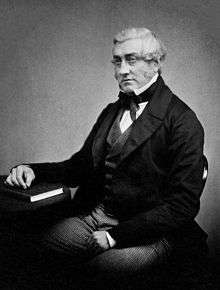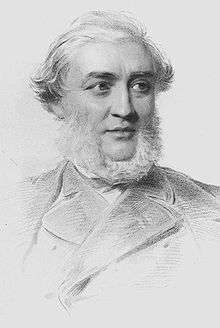Henry Bence Jones
Henry Bence Jones FRS (31 December 1813 – 20 April 1873) was an English physician and chemist.
Henry Bence Jones FRS | |
|---|---|
 | |
| Born | 31 December 1813 |
| Died | 20 April 1873 (aged 59) |
| Education | Harrow School |
| Alma mater | Trinity College, Cambridge University of Giessen |
| Spouse(s) | Lady Millicent Acheson
( m. 1842; |
| Children | 7 |
| Parent(s) | William Jones Matilda Bence Jones |
| Relatives | William Bence Jones (uncle) |

Early life
Bence Jones was born at Thorington Hall, Stoke-by-Nayland, Suffolk, the son of Lieutenant Colonel William Jones, an officer in the 5th Dragoon Guards, and Matilda (née Bence) Jones (a daughter of the Rev. Bence Bence of Thorington Hall, Suffolk). His elder brother was the prominent agriculturist William Bence Jones, who married Caroline Dickinson (a daughter of William Dickinson, MP).
He attended school in Hingham, Norfolk, as well as a private school in Putney.[1] He entered Harrow in 1827 and then went up to Trinity College, Cambridge in 1832, obtaining his degree in 1836.[2] He initially worked for an apothecary but subsequently (1838) enrolled to study medicine at St George's Hospital, and in 1839 chemistry at University College, London. In 1841 he went to Giessen in Germany to work at chemistry with Liebig.[3]
Career
On his return he took a post at St George's hospital and after being promoted to assistant physician was elected in 1846 to full physician, resigning on health grounds in 1862. In 1847, he described the Bence Jones protein, a globulin protein found in blood and urine, suggestive of multiple myeloma or Waldenström's macroglobulinemia.[4]
Besides becoming a fellow, and afterwards senior censor, of the Royal College of Physicians, and a fellow of the Royal Society, he held the post of secretary to the Royal Institution for many years. He delivered the Croonian Lecture to the Royal College of Physicians on Matter and Force in 1868.[5]
He wrote, in addition to several scientific books and a number of papers in scientific periodicals, The Life and Letters of Faraday (1870).[6]
Personal life
On 28 May 1842, he was married to his second cousin, Lady Millicent Acheson, daughter of Archibald Acheson, 3rd Earl of Gosford and Lady Theodosia Brabazon (daughter of John Brabazon, 10th Earl of Meath).[7] Together, they had seven children.
He died in London on 20 April 1873 and was buried in Kensal Green Cemetery. His widow died on 29 August 1887.[7]
See also
References
- "HENRY BENCE JONES – PHYSICIAN, CHEMIST, SCIENTIST AND BIOGRAPHER: A MAN FOR ALL SEASONS" (PDF). British Journal of Haematology. 115 (1): 13–8. October 2001. doi:10.1046/j.1365-2141.2001.02962.x. PMID 11722404. Archived from the original (PDF) on 8 November 2016. Retrieved 24 September 2010.
- "Jones [post Bence-Jones], Henry Bence (JNS831HB)". A Cambridge Alumni Database. University of Cambridge.
- Chisholm 1911.
-

- Rosenfeld L (1987). "Henry Bence Jones (1813–1873): the best "chemical doctor" in London" (PDF). Clin. Chem. 33 (9): 1687–92. PMID 3304718.
- Payne, Joseph Frank (1892). . In Lee, Sidney (ed.). Dictionary of National Biography. 30. London: Smith, Elder & Co.
- "Gosford, Earl of (I, 1806)". www.cracroftspeerage.co.uk. Heraldic Media Limited. Retrieved 4 June 2020.
External links
| Wikimedia Commons has media related to Henry Bence Jones. |
- Henry Bence Jones at Who Named It?
- Dr Bence Jones and the History of Free Light Chains